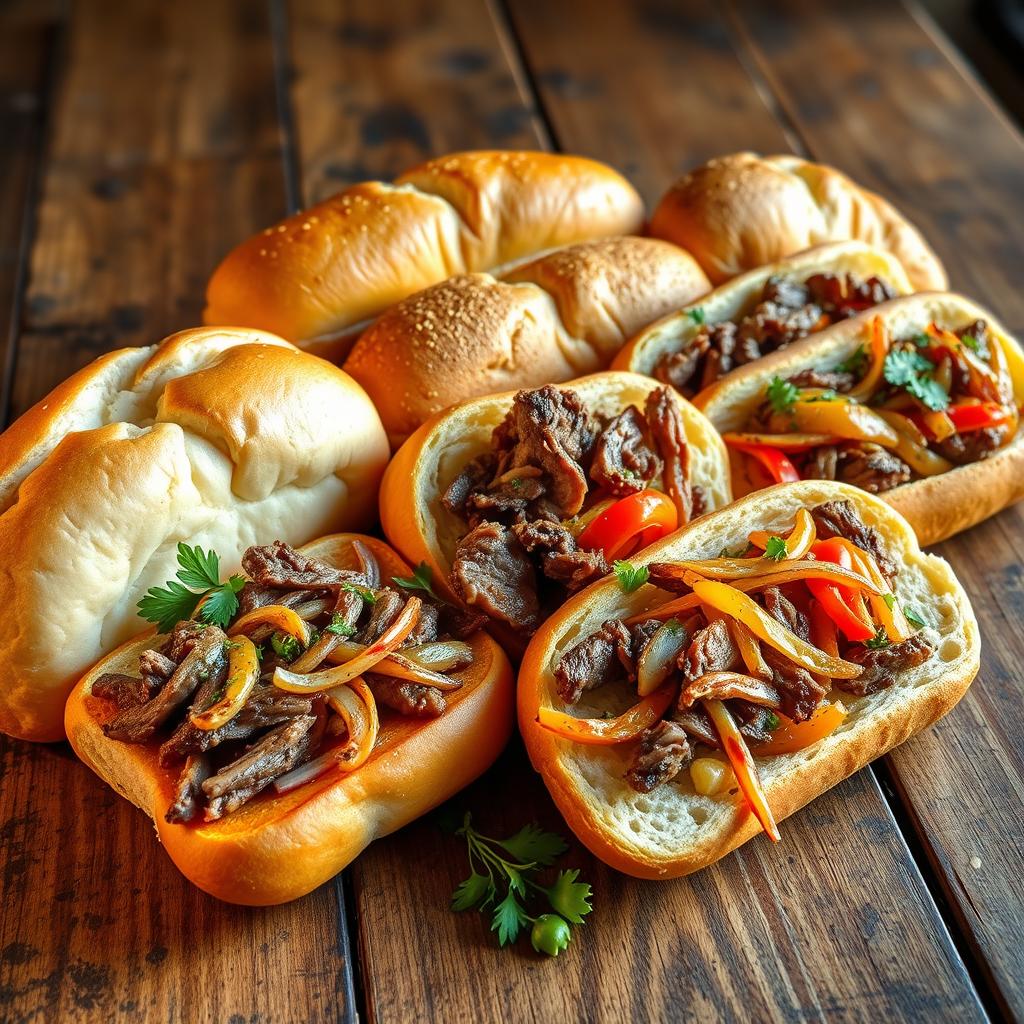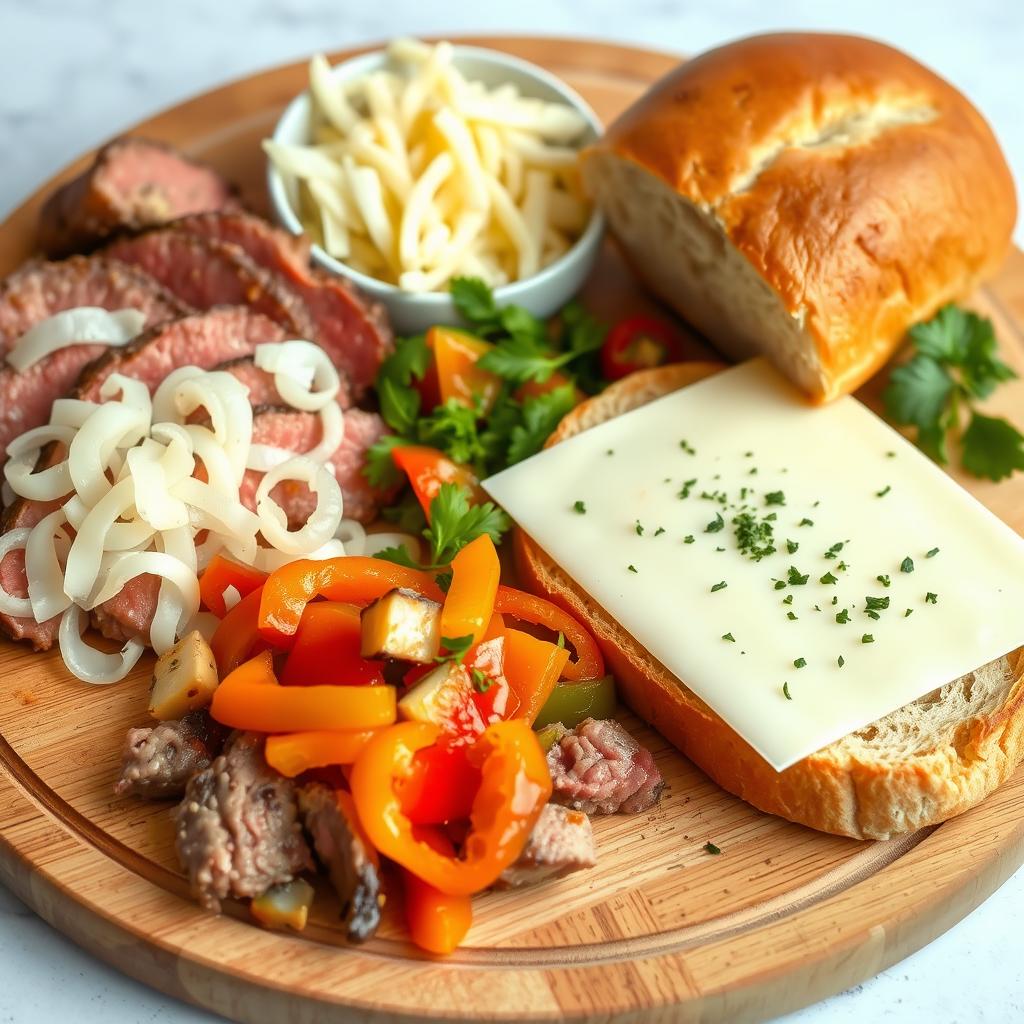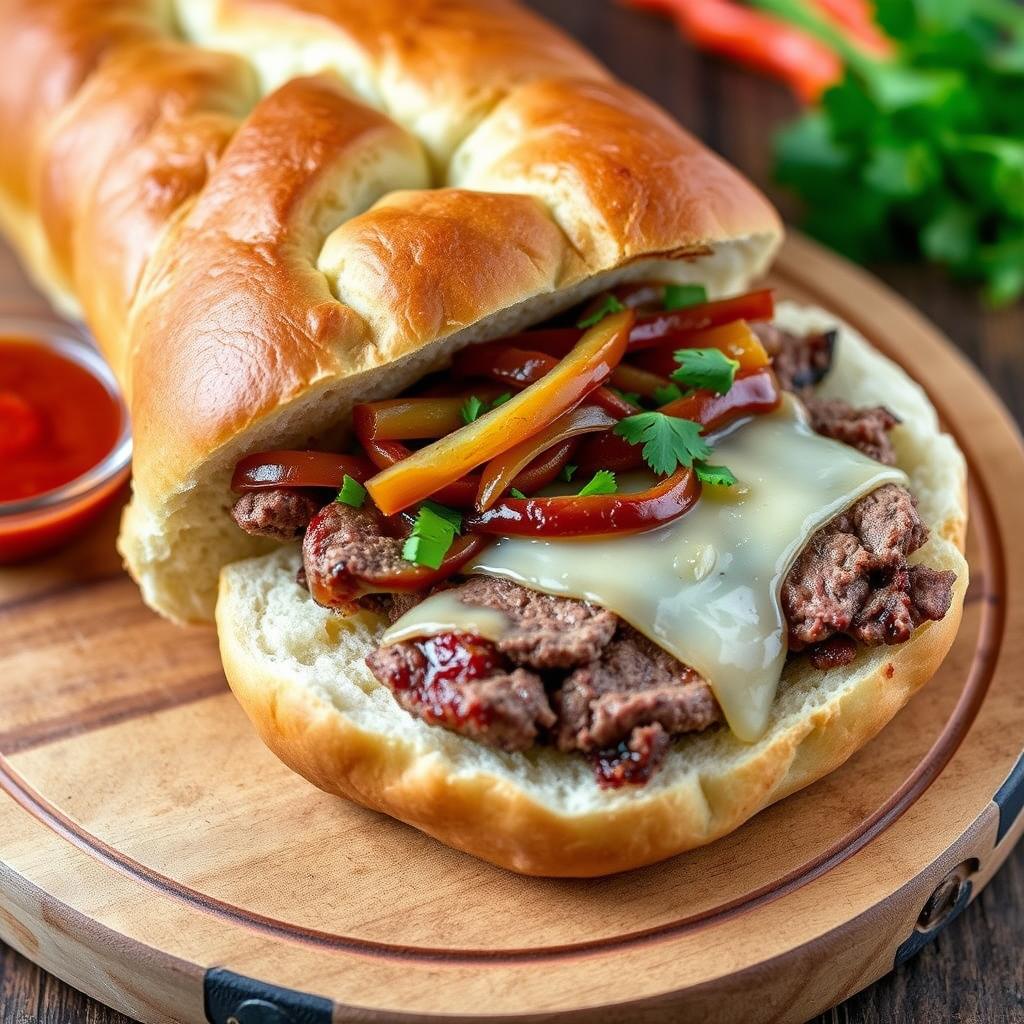Making your own sandwich rolls can turn a simple Philadelphia cheesesteak into a masterpiece. Baking authentic cheesesteak bread at home brings out flavors and textures that store-bought rolls can’t match. The art of making Philadelphia rolls is more than just cooking. It’s a way to show love for traditional American cuisine.
To make perfect homemade sandwich rolls, you need to know the right mix of ingredients and techniques. Each bite of homemade cheesesteak bread tells a story of hard work and pride. From the crunchy outside to the soft inside, these rolls make your sandwich experience special.
Key Takeaways
- Homemade bread offers superior taste and texture
- Philadelphia rolls are crucial to authentic cheesesteaks
- Baking your own bread allows complete control over ingredients
- Fresh, handmade rolls enhance overall sandwich quality
- Mastering cheesesteak bread is a rewarding culinary skill
Understanding the Perfect Philadelphia Cheesesteak Bread
Finding the right bread for a classic Philadelphia cheesesteak is an art. It’s deeply rooted in culinary tradition. The journey of hoagie rolls starts with understanding their unique traits and history.

History of Traditional Philly Rolls
Philadelphia’s bread-making history is rich and full of innovation. Hoagie rolls became the perfect bread for cheesesteaks in the early 20th century. Street vendors and local bakeries created a bread that could hold big fillings yet stay soft inside.
- Originated in Philadelphia’s working-class neighborhoods
- Designed to hold substantial meat and cheese fillings
- Developed through decades of local culinary expertise
Characteristics of Authentic Hoagie Rolls
What kind of bread is used for cheesesteak? True Philadelphia hoagie rolls have unique qualities. They are different from regular sandwich breads:
| Characteristic | Description |
|---|---|
| Texture | Crispy outside with soft, airy inside |
| Length | Typically 6-8 inches long |
| Crust | Slightly crusty but not tough |
The Amoroso Legacy
Amoroso rolls are known for authentic Philadelphia cheesesteaks. This legendary bakery set a standard that locals and home cooks still follow today.
“A great cheesesteak starts with a perfect roll” – Philadelphia Culinary Tradition
The art of making the ideal hoagie roll is a source of pride for Philadelphia bakers. They make sure each sandwich is a piece of the city’s rich culinary heritage.
Essential Ingredients for Cheesesteak Bread Making

To make authentic bakery bread for your cheesesteak, you need the right ingredients. Professional bakers know that quality ingredients are key. They make delicious Italian bread, perfect for a classic Philadelphia sandwich.
When making cheesesteak buns, you’ll need a few important ingredients:
- High-protein bread flour
- Active dry yeast
- Warm water
- Granulated sugar
- Salt
- Olive oil
“The secret to great bread is using fresh, high-quality ingredients and understanding their interactions.” – Master Baker Michael Romano
The flour you choose greatly affects your bread’s texture. Bread flour with more protein makes the bread chewy and robust. This is what defines traditional hoagie rolls. Active dry yeast is key for the air pockets that make cheesesteak buns unique.
Professional bakers suggest using:
- Unbleached bread flour (12-14% protein)
- Fresh, active yeast
- Filtered water at the right temperature
Each ingredient is vital in making tasty cheesesteak bread. It captures the essence of Philadelphia’s culinary tradition.
Mastering the Art of Cheesesteak Bread Dough
Making the perfect soft bread rolls for cheesesteaks needs skill and precision. The journey starts with understanding how to prepare the dough.
When making soft bread rolls, the type of rolls for cheesesteaks is key. Your dough-making skills will make or break your sandwich bread.
Proper Kneading Techniques
Kneading is vital for the right texture in your rolls. Here are the key steps:
- Start with room temperature ingredients
- Use the heel of your hand to push and fold the dough
- Knead for 10-12 minutes until smooth and elastic
- Test dough readiness with the windowpane test
Optimal Fermentation Times
“Great bread is a result of patience and precision.” – Artisan Baker
Fermentation makes your dough rich in flavor and texture. Follow these guidelines:
- First rise: 1-2 hours at room temperature
- Punch down and shape the dough
- Second rise: 30-45 minutes before baking
Shaping Methods for Perfect Rolls
The shape of your soft bread rolls is key for a real cheesesteak look. Find a method that makes uniform rolls with a soft inside and a crisp outside.
- Use gentle hands to shape the dough
- Avoid overworking the dough
- Create elongated rolls typical of Philly-style hoagies
By mastering these techniques, you’ll make professional-quality soft bread rolls for your cheesesteak.
Creating the Perfect Texture for Your Sandwich Rolls
Making the perfect steak bread is all about finding the right mix. You want a crispy outside and a soft inside. This balance is key to a great Philly cheesesteak.
- Hydration levels of the dough
- Precise kneading techniques
- Controlled fermentation process
- Proper baking conditions
“A great cheesesteak starts with exceptional bread that can hold up to juicy meat and melted cheese without falling apart.”
What makes a cheesesteak different from a Philly cheesesteak? It’s the bread. Philly rolls are special. They’re strong enough to soak up juices but still keep their shape.
| Texture Characteristic | Ideal Qualities |
|---|---|
| Crust | Crisp and golden brown |
| Interior | Soft and slightly chewy |
| Moisture Absorption | High without becoming soggy |
Professional bakers suggest trying different flours and dough moisture. Your aim is a bread that enhances the cheesesteak’s flavors and offers a great texture.
Step-by-Step Guide to Baking Italian-Style Steak Bread
Making the perfect italian bread for hoagies needs care and love. Your journey starts with learning the art of bread baking.
Creating great bread requires focus and skill in certain techniques. Experts say the best bread for hoagies is about technique and quality ingredients.
Temperature Control Tips
Controlling the temperature is key for perfect bread. Your oven should be at about 450°F for even baking. Use an instant-read thermometer to check the bread’s internal temperature. It should be 190-200°F when done.
- Preheat baking stone for 45 minutes
- Use middle rack for consistent heating
- Rotate bread halfway through baking
Steam Baking Secrets
Steam helps make a crisp, golden crust. Bakers use water sprayers or ice cubes for moisture in the first 10 minutes of baking.
“The perfect crust is achieved through precise steam application” – Artisan Baker’s Handbook
Achieving the Golden Crust
To get a stunning golden crust, brush your dough with an egg wash before baking. This gives your hoagie rolls a glossy, professional look.
- Egg wash ingredients: 1 egg + 1 tablespoon water
- Brush gently before placing in oven
- Bake until deep golden brown
Mastering these techniques turns home baking into something amazing. You’ll get bakery-quality italian bread every time.
How to Store and Preserve Your Homemade Cheesesteak Bread
Keeping your freshly baked bread fresh is key. After baking your cheesesteak rolls, the right storage keeps them tasty for days.
Thinking about toasting your Philly cheesesteak bun? Storing it right is essential. Here are some tips to keep your bread fresh:
- Room Temperature Storage
- Keep rolls in a paper bag for 1-2 days
- Avoid plastic bags which trap moisture
- Store at room temperature away from direct sunlight
- Freezing Techniques
- Wrap individual rolls in plastic wrap
- Place in freezer-safe bags
- Freeze for up to 3 months
To keep your bread fresh, vacuum seal it. This stops freezer burn and keeps the taste great.
“The secret to great bread is not just in baking, but in preserving its original texture and flavor.” – Artisan Baker’s Wisdom
| Storage Method | Duration | Best For |
|---|---|---|
| Counter Top (Paper Bag) | 1-2 days | Immediate Consumption |
| Refrigerator | 3-5 days | Short-Term Preservation |
| Freezer | Up to 3 months | Long-Term Storage |
Pro Tip: Let frozen bread thaw at room temperature. Then, briefly reheat it in the oven to get its original texture back.
Common Mistakes to Avoid When Making Hoagie Rolls
Making perfect hoagie rolls for your cheesesteak can be tricky. Knowing what kind of bread is used for cheesesteak is just the first step. Many home bakers face challenges that can stop them from making the ideal rolls.
When making hoagie rolls, several common pitfalls can ruin your bread-making efforts. Knowing these issues helps you make delicious, professional-quality rolls every time.
Troubleshooting Dense Texture
A dense, heavy hoagie roll can ruin your cheesesteak experience. This problem often comes from a few key mistakes:
- Overworking the dough, which develops too much gluten
- Using old or inactive yeast
- Not allowing proper rising time
- Using incorrect flour measurements
“The secret to light, airy hoagie rolls is patience and precision.” – Professional Baker
Fixing Crust Issues
Achieving the perfect crust for your cheesesteak bread requires attention to detail. Here are some solutions to common crust problems:
| Crust Problem | Solution |
|---|---|
| Pale, Soft Crust | Increase oven temperature, use egg wash |
| Tough Crust | Reduce baking time, add steam to oven |
| Uneven Browning | Rotate pan, use middle oven rack |
By understanding these common mistakes, you can elevate your hoagie rolls from amateur to artisan. Practice and attention to detail make all the difference in creating the perfect bread for your cheesesteak.
Variations of Traditional Cheesesteak Bread
Trying out different sandwich rolls can change how you enjoy cheesesteaks. While classic hoagie rolls are always a hit, there are many other options. These alternatives add new flavors and textures to the traditional cheesesteak buns.
Looking for what are cheesesteak buns called? You’ll find many exciting options:
- Whole Wheat Rolls: Nutritious and hearty, offering a nutty undertone
- Sourdough Variations: Tangy flavor profile with robust texture
- Gluten-Free Options: Perfect for dietary restrictions
Each option brings its own special touch to sandwich rolls. Trying out different bread styles can make your cheesesteak truly stand out.
“The bread makes the sandwich, not just the filling” – Philadelphia Bread Artisan
| Bread Type | Flavor Profile | Texture |
|---|---|---|
| Classic Hoagie | Neutral, slightly sweet | Soft, slightly crusty |
| Whole Wheat | Nutty, earthy | Denser, more substantial |
| Sourdough | Tangy, complex | Chewy, robust |
| Gluten-Free | Mild, adaptable | Variable, can be softer |
Your choice of bread can really change how you enjoy a cheesesteak. Pick the right one and get ready for a culinary adventure!
Pairing Your Homemade Rolls with Classic Philly Ingredients
Making the perfect cheesesteak starts with picking the right ingredients for your philadelphia rolls. The mix of bread, meat, and cheese turns a simple sandwich into a work of art.
Cheese Selection Strategies
When picking cheese for your cheesesteak, think about these classic choices:
- Cheez Whiz: The traditional Philadelphia favorite
- Provolone: A creamy, mild alternative
- American cheese: Melts perfectly and adds rich flavor
Meat Selection Guidelines
The right meat is key to a great cheesesteak. What kind of rolls are used for cheesesteaks? They go best with these meats:
- Ribeye steak: Tender and flavorful
- Sirloin: Leaner but still delicious
- Top round: Budget-friendly option
“A great cheesesteak is all about balance and quality ingredients” – Philadelphia Food Experts
Pro tip: Slice your meat thin and cook it quickly to keep it tender. The right philadelphia rolls will match your meat and cheese, making a perfect sandwich.
Conclusion
Making your own cheesesteak bread takes your cooking to a whole new level. You’ve learned the secrets of making authentic Philadelphia-style rolls. This shows that baking is both an art and a science.
Understanding the difference between a cheesesteak and a Philly cheesesteak is key. It all comes down to mastering the basics of bread-making.
Creating cheesesteak bread is a journey that needs patience, practice, and passion. Every batch you make helps you get closer to the perfect hoagie roll. Your hard work will turn every sandwich into a masterpiece.
Great bread is the heart of a fantastic cheesesteak. By learning traditional methods and trying new things, you’ll make delicious rolls. You’ll also connect with a rich culinary tradition.
Your homemade cheesesteak bread will tell a story of dedication and skill. It’s a celebration of authentic American cuisine.
Take on the challenge, trust your abilities, and enjoy the tasty results of your bread-making journey. Each roll you bake brings you closer to making the perfect sandwich.
FAQ
What makes Amoroso rolls special for Philly cheesesteaks?
Amoroso rolls are famous in Philadelphia for their soft yet strong texture. They’re perfect for holding the juicy cheesesteak filling. These classic rolls have been a must for real Philly cheesesteaks since the early 20th century.
They offer a light, airy inside with a slightly crisp crust. This makes them great for holding steak and cheese without falling apart.
Can I make authentic cheesesteak bread at home?
Yes, you can make authentic cheesesteak bread at home. Use high-protein bread flour and active dry yeast. Follow traditional hoagie roll techniques to get the right softness and structure.
The goal is to make a bread that’s soft but can hold heavy fillings. It should also stay light and airy.
What’s the difference between a cheesesteak and a Philly cheesesteak?
There’s no difference. A Philly cheesesteak is the original and authentic version. It’s made with thinly sliced beef, melted cheese, and served on an Amoroso roll or similar Philadelphia-style roll.
What type of bread works best for a cheesesteak?
The best bread is a long, soft hoagie roll. It should have a slightly crisp exterior and a soft interior. Authentic Philadelphia-style rolls like Amoroso’s are perfect. They can hold up to juicy meat and melted cheese without getting soggy.
Should I toast the cheesesteak roll?
Toasting the roll lightly can be good. It creates a slight barrier that prevents sogginess. It also adds a subtle crunch to your sandwich.
What are the key characteristics of a traditional cheesesteak roll?
A traditional roll should be long and slightly crusty on the outside. It should have a soft, white bread interior. It needs to be sturdy enough to hold the filling without falling apart.
It’s usually about 10-12 inches long. It’s made with high-protein flour for the perfect texture.
Are there variations of cheesesteak bread?
Yes! There are variations like whole wheat, sourdough, and gluten-free options. Each variation offers a unique flavor and texture. They let you choose based on personal preference and dietary needs.
How do I store homemade cheesesteak rolls?
Store homemade rolls in an airtight container at room temperature for 2-3 days. Or freeze them for up to a month. Wrap individual rolls in plastic wrap or aluminum foil to keep them fresh.

